Italian Ports
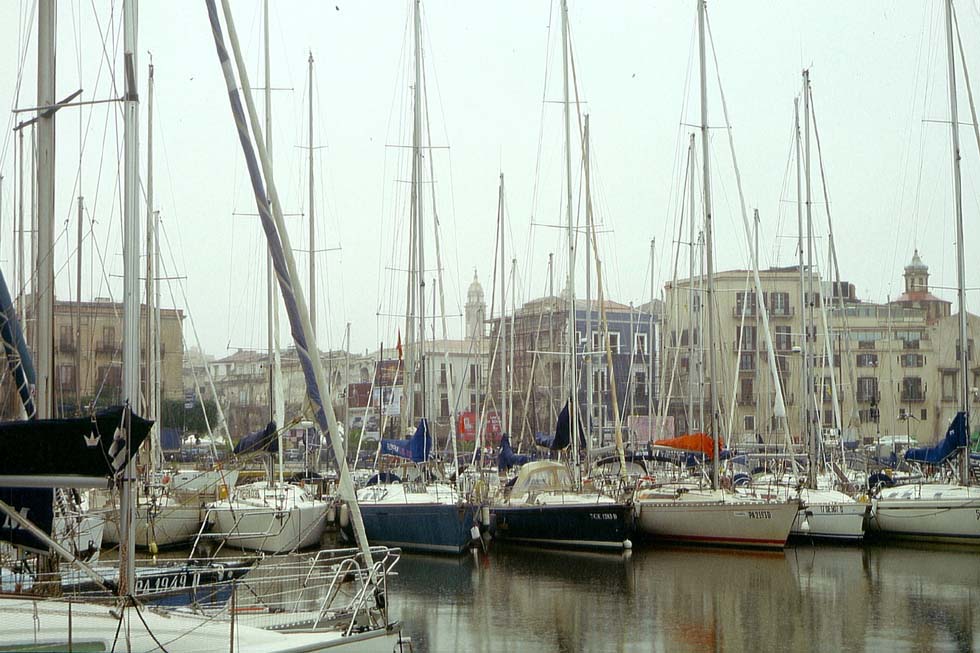
Palermo (WS)
The Kingdom of Italy was founded in 1861 with French assistance when Conte di Cavour, supported by the voluntary corps of Garibaldi, unified the country under King Vittorio Emanuele II of Savoy (and Sardinia). Cavour favoured an Indian Mail route by train to Genoa, where the mail steamers should call. In 1847 a contract with the P&O for a preliminary operation was made, but the British Post Office thought already of an overland route via Brindisi or Otranto for the future, by the shorter way of the Adriatic Sea.
Already in 1818 the 185-ton paddle-steamer "Ferdinando I" of the French officer M. Mandriel had undertaken a spectacular voyage from Naples to Marseilles. A decade passed until Marseilles was reached by steamers from Sardinia. Then Raffaele Rubattino and Gaetano di Luchi founded Ditta de Luchi e Rubattino and in 1839 their "Dante" took up regular services from Genoa to Marseilles and Naples. They were extended, becoming known as Rubattino. Sicily was linked already in the middle of the 19th century by the Pace brothers of Palermo. And there were other operators, too. In 1881 the companies Florio and Rubattino were amalgamated to form Navigazione Generale Italiana (NGI) .
Norddeutscher Lloyd (NDL) started in 1886 and once again in 1894 a short-term coastal service, the latter between Genoa and Palermo with the steamer "Danzig". The Hamburg- Amerika Linie, known as Hapag, entered the emerging Mediterranean tourist business with a service from Genoa to the Riviera in 1902, initially with the paddle-wheeler "Cobra". Hapag and NDL were engaged also in the traffic to Egypt (see chapter Levante). In 1908 started a CIWL de-luxe train Lloyd-Express Hamburg - Genoa. Between the wars a daily express from Rome terminated at Naples Marittima station alongside the Italian steamers.
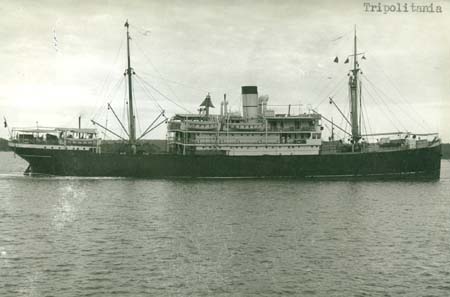 "Tripolitania" of Tirrenia (old card, coll. WS)
"Tripolitania" of Tirrenia (old card, coll. WS)
Towards the end of the 19th century the Navigazione Generale Italiana was the provider of services also to North Africa. From c. 1910 the company concentrated on North Atlantic services. The Adria Line added later North Africa services. Libya was conquered in 1911 and Tripoli became its port for services from Italy, provided by Adria Line and by the Societa 'Sicilia', which connected also Tunesia.
'Italia' Flotte Riunite, formed in the 30s and famous for their Atlantic services, used later their motor-ships "Saturnia" and "Vulcania" for Mediterranean services. There were innumerable coastal and island services by various companies. Between the wars the black/white steamers of Tirrenia, created in 1932 by the government with the merger of Florio and CITRA, in 1936 joined by Adria of Fiume (Rijeka), became the most active on Mediterranean routes. Also after WWII Tirrenia held its position. The timetable (e.g. Orario Pozzo of 1952) listed services Naples - Tunis with the motor vessels "Giosue Borsi", "Cagliari", "Citta di Tunisi" and from Palermo also the steamers "Ichnusa" and "Torres". For Eastern Mediterranean routes see chapter Levant.
Car Ferries
Tirrenia kept its leading position also after WWII, serving Valencia, Marseilles and Tunis with motor-ships of less than 3,000 tons. Several small ships with three decks added were sold for Red Sea services and got a bad reputation when the former "Boccaccio" capsized in 2006. With its amazing hi-speed fleet of waterjet monohull vessels the company became a pioneer in that technology. The 3,500-ton "Guizzo" and "Scatto" of Rodriquez' Aquastrada type were followed by "Aries", "Capricorn", "Scorpio" and "Taurus". This Fincantieri MDV3000 Jupiter type of c. 11,350 gt with additional gas-turbines is capable of carrying 1,800 passengers and 460 motorcars at a speed of 40 knots. They suffered under rising fuel cost, nevertheless Tirrenia ferries continued to connect almost every island. However, state-owned Tirrenia, owner also of Divisione Adriatica, Caremar, Saremar, Siremar and Toremar, was debt-laden and in 2009 Lloyd's List presumed under the headline "Any takers for Tirrenia" Moby, GNV, Ustica and giant MSC of Gianluigi Aponte. In 2011 finally Tirrenia was privatized, changing to CIN, a group participated by Grimaldi, MSC and Moby Line.
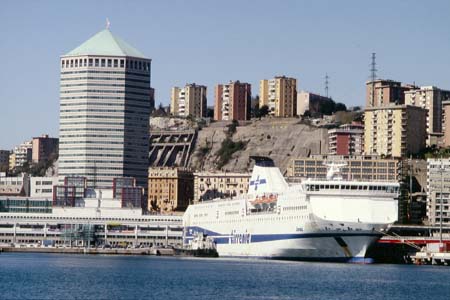
"Janas" of Tirrenia, Genoa 2009 (WS)
|
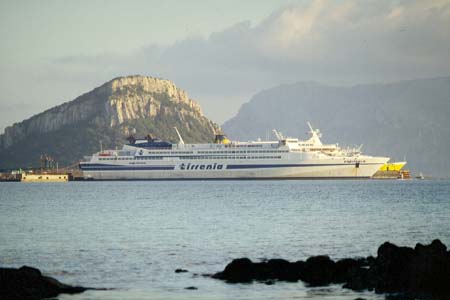
"Capricorn" at Golfo Aranci, Sardinia 2006 (WS)
|
A pioneer in international car ferry services was Traghetti Canguro, a joint service by the Italian enterprises Societa Navi Traghetto and Traghetti Sardi together with Canguro Iberia of Spain. Their nice ferries, the names beginning with "Canguro", inaugurated in the 60s services Barcelona - Genoa and Italian domestic routes. There were other pioneers, too. The Shipping Guide listed e.g. in 1978 a service Genoa - Malaga and Tunis by Danish Seaways. An early service from Toulon to Palermo had been provided by T.T.T. Line.
Grimaldi
Several car ferry pioneers disappeared. With ro-pax shipping, main players have become the Grimaldi enterprises. In the 1960s, Grimaldi Siosa Lines/Sicula Oceanica SA of Genoa, the latter having its roots in the early 20th century, were still listed with transoceanic passenger services. In the '80s the label GRIMALDI LINES appeared on transoceanic ro-ro ships. The vessels of the Republica class with limited passenger accomodation, listed for Atlantica SpA, Granferry, Grinavi and Siosa, then Grimaldi Cia. di Navigazione, Palermo (according to Kludas), started operations even to South America.
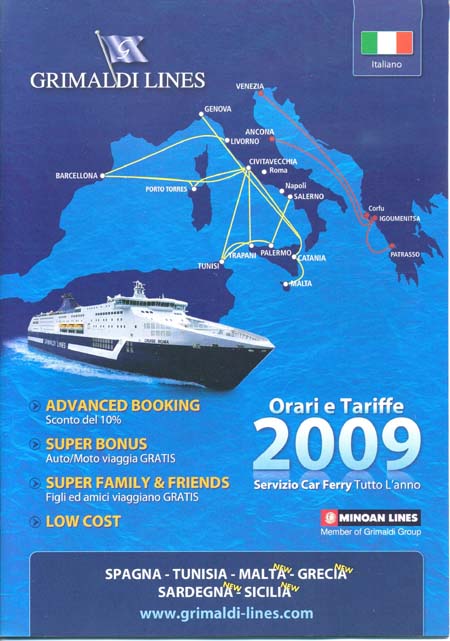
"Cruise Roma" (Grimaldi Lines)
|
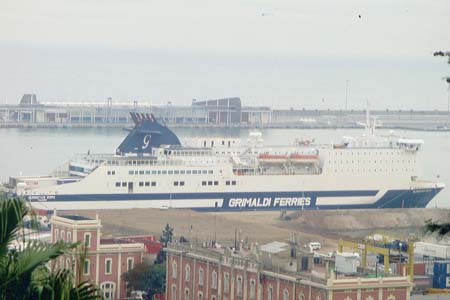
"Eurostar Roma" ex "Superfast I", Barcelona 2008 (WS)
|
The Grimaldi Group Naples was founded in 1945, according to its Web site. Grimaldi targeted around 1970 with the advanced newbuild "Freccia Rossa" the way towards modern ro-pax vessels. The "Eurostar Valencia" (2003/25,984 gt) opened a Civitavecchia - Toulon service in cooperation with LD, sporting a GRIMALDI-LOUS DREYFUS label, known as GLD Lines, a joint venture. Sister "Eurostar Salerno", like the later ro-pax vessels labeled GRIMALDI FERRIES, the dark-blue funnel decorated with the letter 'G', started the Civitavecchia - Tunis service in 2005. Step by step the Grimaldi Group, concentrating on long routes, extended operations. In 2008 Grimaldi Lines opened a new dimension with the "Cruise Roma" (54,310 gt, 1,200 pax, 3,040 lanem), introduced on the Civitavecchia - Barcelona route, then joined by sister "Cruise Barcelona". The route was operated before with the "Eurostar Roma" (ex "Superfast I") and "Eurostar Barcelona" (ex "Prometheus" in Minoan charter), intended to become "Eurostar Tunis". A class of smaller ro-pax ships with 2,700 lanem followed from 2008 on. For the widespread activities of Emanuele Grimaldi see also the chapters Baltic Sea, Adriatic and Aegean.
Grandi Navi Veloci
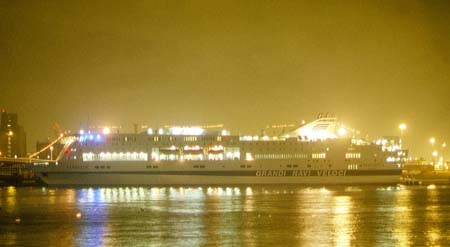
"Fantastic", Barcelona 2007 (WS)
|
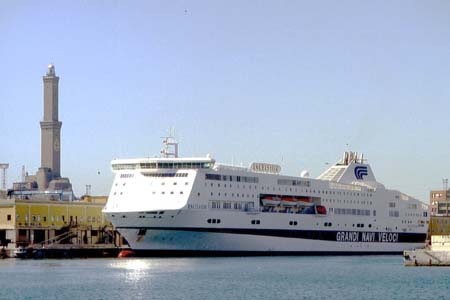
"Excelsior", Genoa 2009 (WS)
|
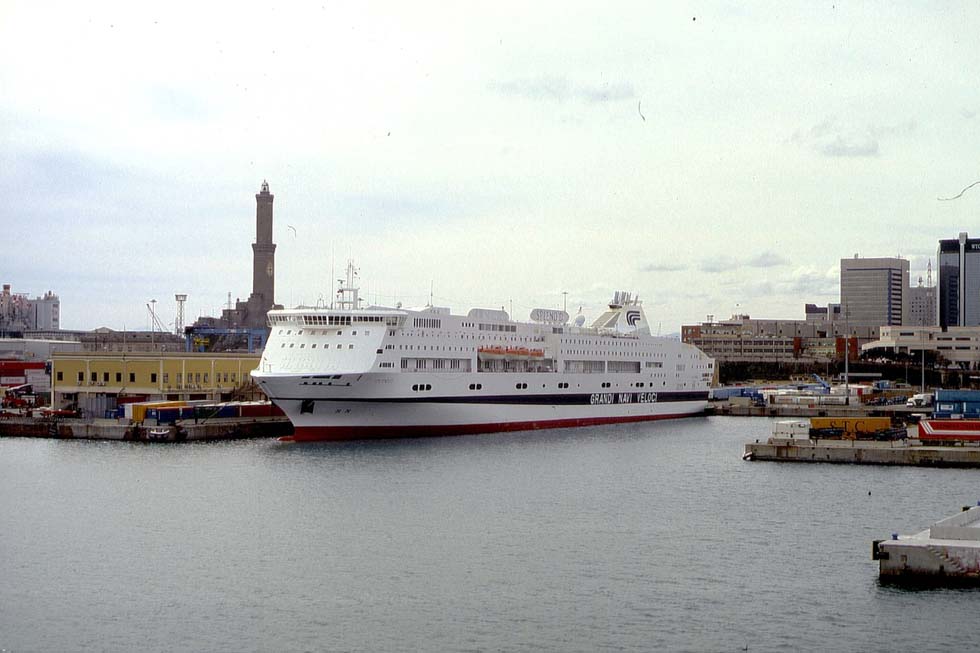
"Splendid", Genoa 2009 (WS)
The label GRIMALDI LINES appeared also on the new white car ferry "Majestic" (1993/32,746 gt) and her consorts "Splendid" and "Fantastic", registered for Grandi Navi Veloci, Palermo, founded in 1991 by Aldo Grimaldi. They offered to more than 1,200 passengers a comfort hitherto unknown on the routes from Genoa. The "Fantastic" opened in 1998 the Genoa - Barcelona route, joined by the "Majestic". With the somewhat similar "Excellent" (1998/39,739 gt) and sister "Excelsior" the Civitavecchia (Rome) - Tunis service was started in 2005. The larger cruise ferries "La Superba" and sister "La Suprema" (49,270 gt, 2,800 lanem) of 2002-03 went into service on the Sardinia and Sicily routes. A Genoa - Barcelona - Tangiers service was added. Newbuilds of 26,000 tons followed from 2006.
Sardinia
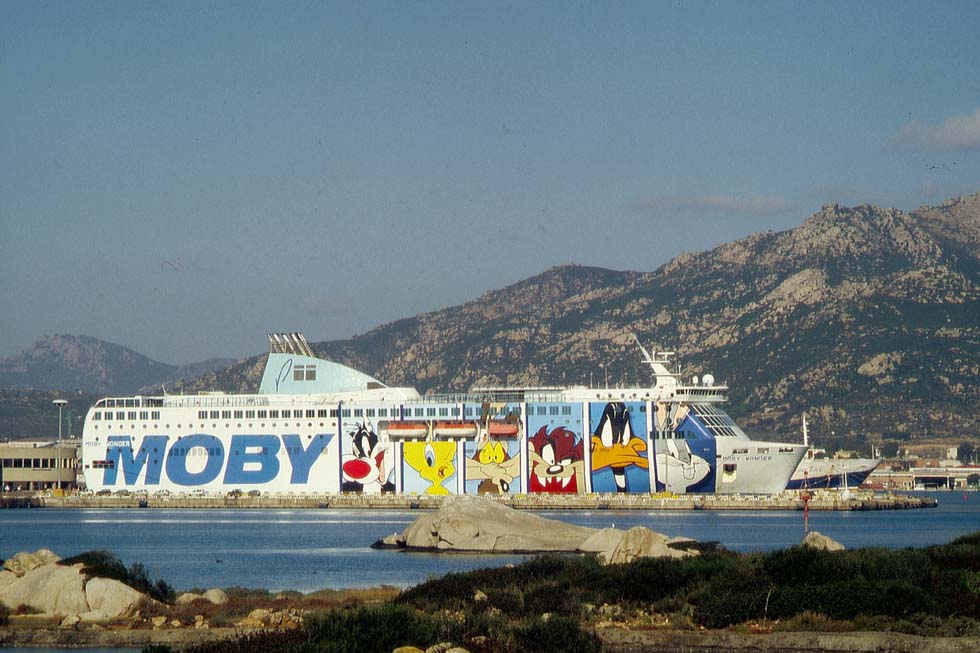
"Moby Wonder", Olbia 2006 (WS)
This island, where the Kingdom of Italy had its roots, was connected before World War I mainly by the Navigazione dello Stato and the Societa 'Sicilia'. Later the steamers of Tirrenia provided the important services. In the early age of car ferries Tirrenia continued to link the island with a route network reaching as far as Genoa and Sicily. In 1961 the state railways FS had inaugurated a freight train ferry service Civitavecchia - Golfo Aranci, offering also motorcar transport and cabins for passengers. The 4,300-ton "Tyrsus" was followed by the "Hermanea" and "Gennargentu" and ferries transferred from Sicily, but in the first years of the 21st century the service disappeared from the timetable. At that time of course Grandi Navi Veloci, Grimaldi and other companies, altogether roughly a dozen, linked half a dozen Sardinian island ports with the mainland. Navarma and Tirrenia connected also Corsica. Tirrenia has created a sensation with the spectacular MDV hi-speeds. Lloyd Sardegna was acquired by Moby Lines. Their colourful ships are an eyecatcher beneath the rocky mountains of the Costa Smeralda. In 1991 the "Moby Prince" had collided with a tanker and 141 people died. Close to Olbia the "Moby Magic" ran aground in 2003, then was laid-up, finally being scrapped. In 2004 the showpiece has become the new "Moby Wonder" class of 36,000 gt with a three-level panoramic lounge. Also Corsica Ferries & Sardinia Ferries connect Italy with Corsica (their Greek subsidiary Kallisti Ferries was only a short-term adventure) and in 2010 SNAV joined this market, too.
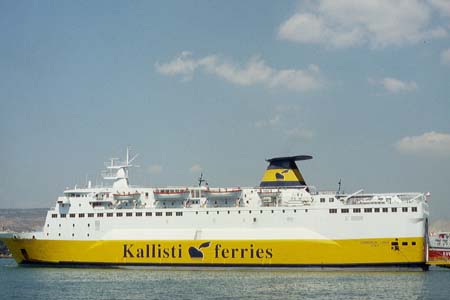
"Sardinia Vera" (ex "Marine Atlantica" for CP), Piraeus 2008 (WS)
|
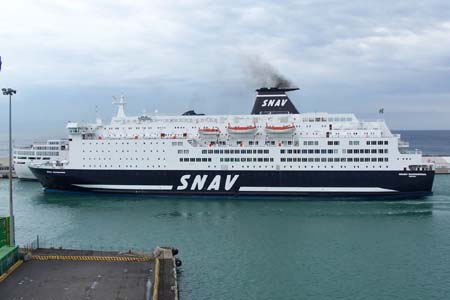
"SNAV Sardegna", Civitavecchia 2007 (sempreblu07, via Wikimedia9)
|
The South
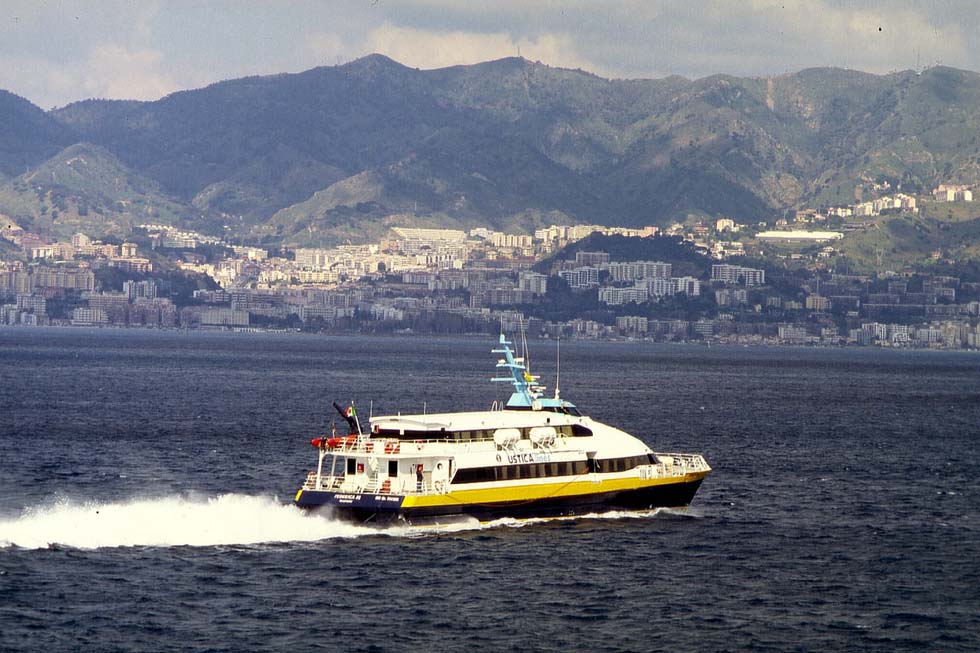
"Federica M" of Ustica Lines, coming from Eolian islands, Strait of Messina 2009 (WS)
Many companies are linking other islands of Italy. For tourists one of the most interesting trips might go from Naples to Capri, once served by the Societa Partenopea and other companies, now by Alilauro, Caremar, Navigazione Libera del Golfo and by Aliscafi SNAV hi-speeds. In the past, steamers of Eolia and Armatore Cirrincione linked other islands. Mainly Siremar and Ustica Lines connect the Eolian islands nowadays and there are many other services on the west coast.
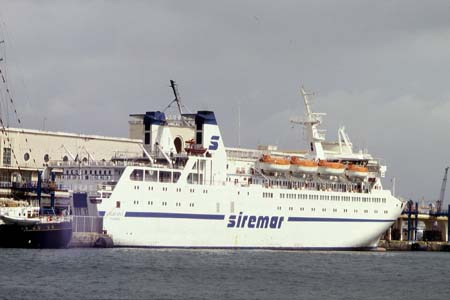
"Laurana", Naples 2009 (WS)
|
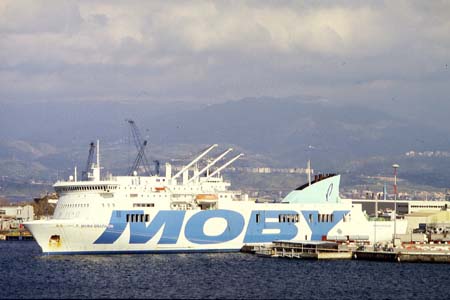
"Maria Graziaon", Messina 2009 (WS)
|
The island of Sicily was linked before WWI mainly by the Adria Line, by Navigazione dello Stato and by foreign companies. The Strait of Messina on the way to Sicily is traditionally served by train ferries of Italian state railways FS - see the relevant chapter. ShipPax listed e.g. in 2006 ten vessels conveying also trucks under the label Bluvia. On the route Reggio di Calabria - Messina, FS introduced passenger-only catamarans, too. Also Ustica hydrofoils, Aliscafi SNAV, merged Caronte & Tourist, Tirrenia, TTT Lines, a subsidiary of TT-Line, and other ferries serve Sicily. Constructing of a gigantic road and railway bridge connecting the island became aimed under the Berlusconi government, opposed by environmentalists and a "ferry mafia", as a Sicilian businessman expressed it. Of course it's no true Mafia, but among the opponents of the railway bridge reportedly were - the railways.
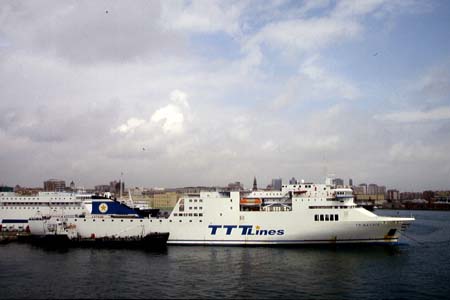
"Trinacria", Naples 2009 (WS)
|
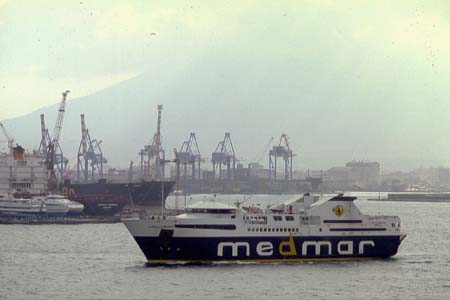
"Lora d'Abundo", Naples 2009 (WS)
|
Alilauro, Grimaldi, Grandi Navi Veloci and Cotunav , temporarily also the Medmar group and Ustica Lines, entered the car ferry business from Italian or Sicilian ports to Tunis. Already in 1982 a daily newspaper had written. "Every Friday the ferry "Campania Felix" is landing in the harbour of Trapani on the west coast. Almost all passengers are Muslims, most of them come from Tunisia. For people of North Africa, Sicily is the 'nearby America'...". Many never reach Europe, they are dying as 'boat people' at the high seas. In 2004 the "Cap Anamur", a charity ship, made headlines when she had saved 37 African refugees from the sure death, for three weeks the authorities refused entry, then the ship was allowed to enter Porto Empedocle and - the captain and the officers were arrested. In 2011, after the tumults in Tunisia, migrants found an easy way to enter France when the Italian government granted them EU visa . whereupon French authorities interrupted international trains at Ventimiglia.
Malta
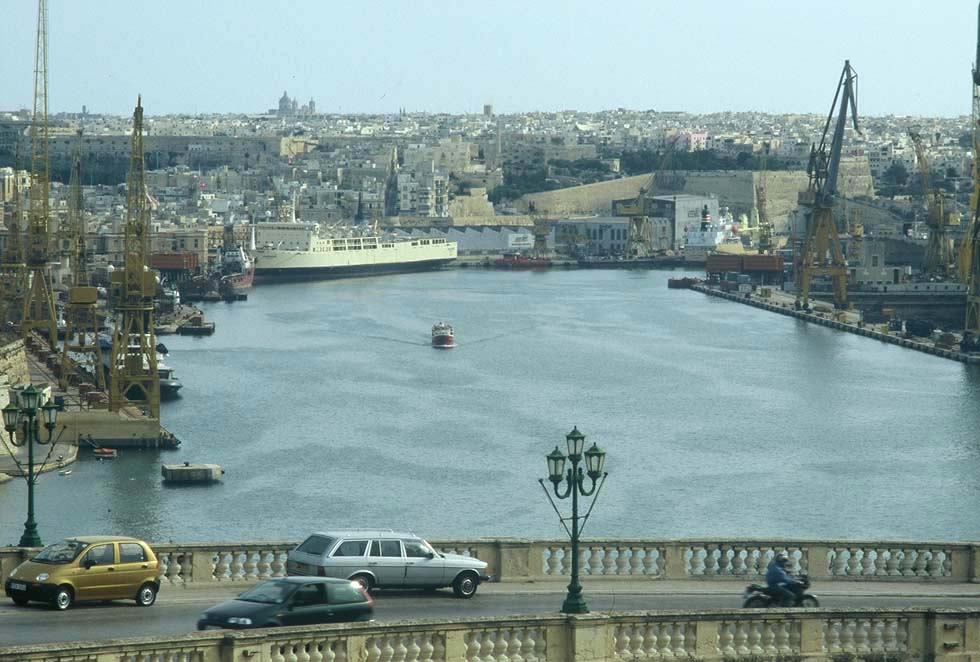
Malta, the port of Valletta, 2001 (WS)
Malta, since 1974 an independent republic, got during her eventful history under the control of various powers. From the 16th century, the island acted as the headquarter of the Maltese Order and became a British naval base in 1800. The gigantic fortifications of Valletta withstood the attacks of the Osman Empire and the heavy air attacks of the Axle Forces during the Second World War. Valetta was port of call of the P&O, by 1897 also with the "Clyde" of the branch line Marseilles - Alexandria, moreover Messageries Maritimes, CGT, Adria, Tirrenia, Papayanni & Ellerman Lines from Liverpool, later General National of Libya and other companies. The "Knight of Malta" of the Casser Co. , introduced in 1930 on Syracuse - Malta services, has been of a nice appearance resembling the P&O "Iris", as Laurence Dunn described it. The steamer service Syracuse - Malta was, in connection with trains, the shortest way from London to that British outpost. Valletta has got in 1863 a metre-gauge rail connection uphill to Museum close to Mdina, shut down in 1931.
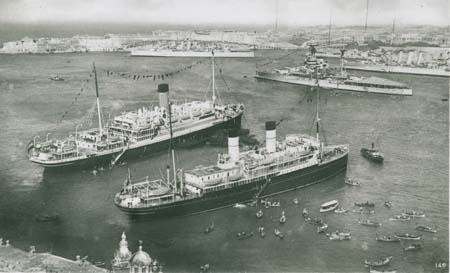 Malta, Grand Harbour and a British battleship ("Royal Oak" or "Ramillies"?) between the wars (old card, coll. WS)
Malta, Grand Harbour and a British battleship ("Royal Oak" or "Ramillies"?) between the wars (old card, coll. WS)
Still in the 50s the timetable listed, apart from other routes, the Laferla Line with a service Syracuse - Malta. Sea Malta closed down, but Grandi Navi Veloci, Grimaldi, Maresi with car ferries and a Virtu catamaran continued to connect the capital Valletta. And there is the little car ferry of the Gozo Channel Co. , the only connection to Gozo Island, which must be maintained even if other services would disappear. Indeed, though Malta has become a member of the EU, in some local "Sir Winston" pub you may feel closer to London than to Italy.
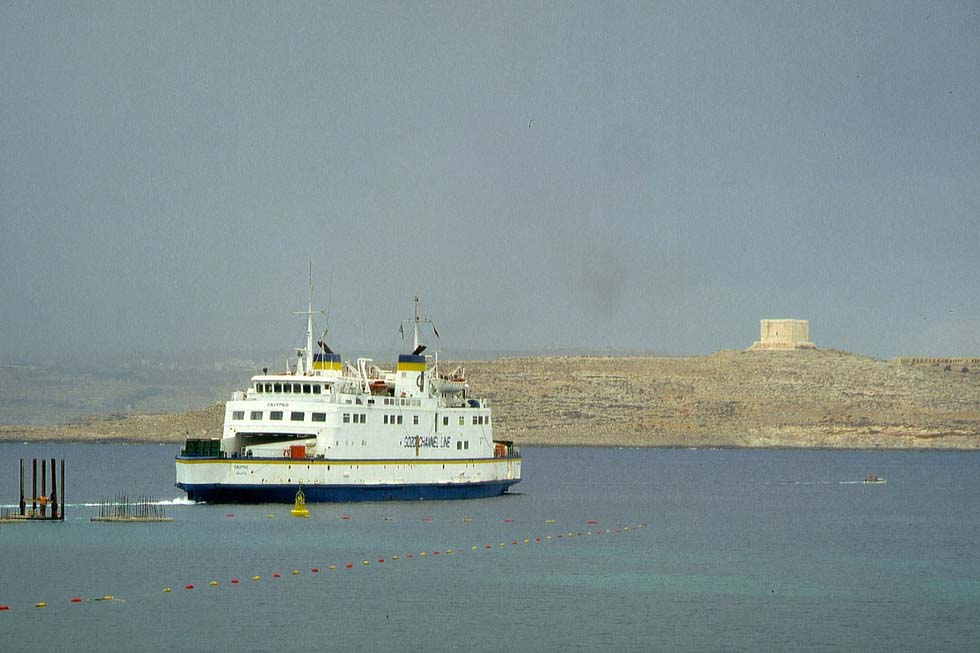
"Calypso", arriving from Gozo at Marfa Point, 2001 (WS)
Libya
That country, initially an Italian colony, has come under British control in 1943 and became an independent kingdom in 1951. Traditionally the port of Tripoli was served by Tirrenia. In the 50s the timetable listed their steamer "Argentina" (5,014 gt) on a Naples - Tripoli route and the motor-ship "Citta di Livorno" (2,499 gt) on a Benghazi route. In 1977 the General National Maritime Transport Co. of Libya acquired two car ferries from Naviera Aznar, the "Toletela" (ex "Monte Toledo"), used on a Barcelona - Naples - Valletta - Tripoli route, and the "Garnata" (ex "Monte Granada"). Then Libya's policy under Muammar al-Gaddafi, who had come into power in 1969, caused an international boycott and all these ferry services ceased operation. In the 21st century, after al-Gaddafi had changed politics, the boycott vanished in 2004. Oil-rich Libya invested in Italy, based on the good relations with Italian prime minister Berlusconi. With the revolt of 2011 and the war for oil, the situation changed in an unforeseen way.
|